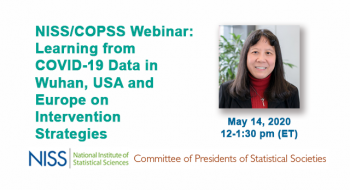
Xihong Lin, Professor and former Chair of the Department of Biostatistics and Professor of Statistics at Harvard University, provided a talk that was sponsored by both the Committee of the Presidents of Statistical Societies (COPSS) and NISS to over 600 attendees. The focus of her comments was on the data surrounding public health interventions that were put into place in Wuhan, China which she then compared to interventions implemented in the United States and in various countries in Europe. Bhramar Mukherjee, John D. Kalbfleisch Collegiate Professor and Chair, Department of Biostatistics, University of Michigan, and current Chair of COPSS, introduced Xihong and served as moderator of the session.
Xihong began her remarks by providing a review of the COVID-19 outbreak in general and the organizations and institutions both involved in research and those providing advice to public officials. This led to a walk-through of a much more detail review of the outbreak as it occurred in Wuhan, China and the surrounding areas, the interventions that were put into place and the results of these interventions. She showed how the data demonstrated that this disease is very infections, however, the data also shows that it can be controlled by social distancing, centralized isolation and quarantine.
Throughout her presentation Xihong emphasized important points by providing nine "Take Home" messages. These messages serve to provide an outline of her talk. The messages included:
- Social distancing greatly helped to flattening the curve but it was not enough.
- Adding centralized isolation and quarantine to social distancing bent the curve and stopped the epidemic.
- Protection of health care workers with comprehensive PPEs, training and PPE supplies is essential.
- Protect the five vulnerable groups: healthcare workers, elderly, family members, essential workers, low-income families.
- Early diagnosis and early medical care is essential.
- A multi-pronged approach is needed to control the epidemic.
- Give testing priority to the five vulnerable groups including asymptomatic and pre-symptomatic cases.
- Wide contact tracing is critical and can be empowered by integrating humanity and technology.
- It is important to effectively educate and communicate with the general public.
Following Xihong's talk moderator Bhramar Mukherjee was very busy assimilating and relaying to Xihong a wide variety of thoughtful and probing questions from the audience! The question session lasted for about 20 minutes before the session came to an end.
Below is a recording of the session as well as a link to the slides used by the speaker for your review.
Recording of the Session
Slides Used by the Speaker
Dr. Xihong Lin
"Learning from Wuhan, US and Europe COVID-19 Data on Public Health Interventions"
